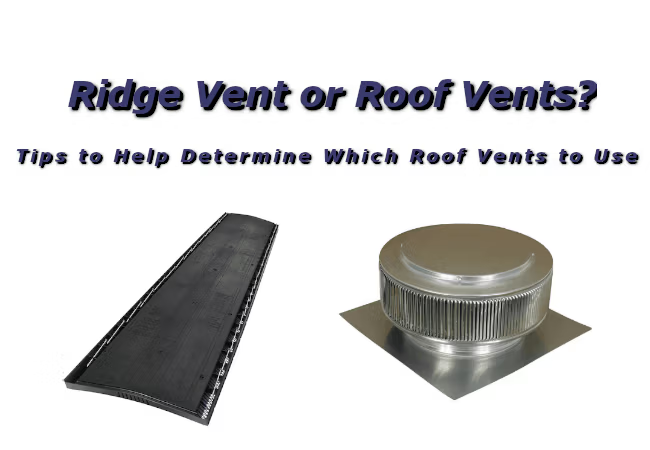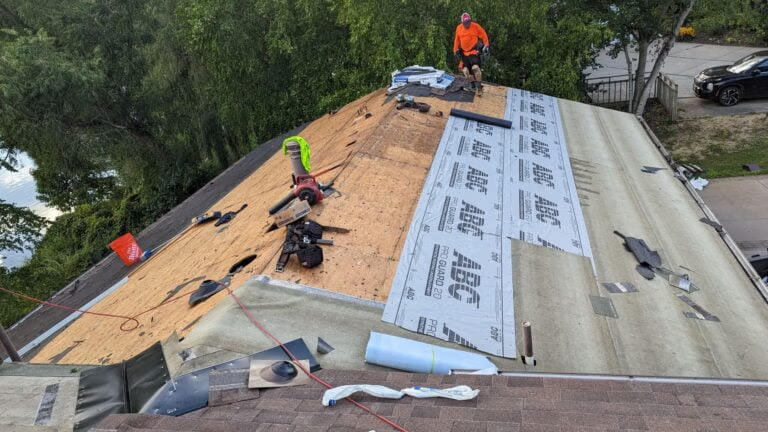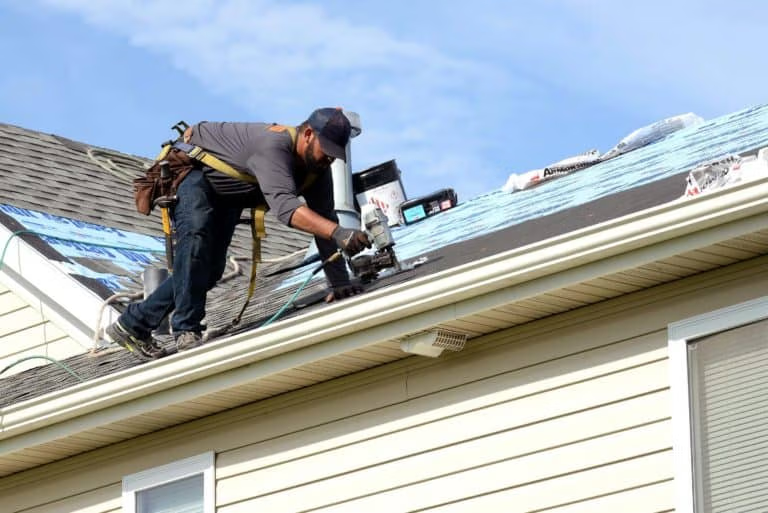Frequently Asked Questions
Can ridge vents be used in combination with roof vents?
Yes, ridge vents and roof vents can be used in combination. The combination of these two ventilation methods can provide effective attic air circulation, preventing moisture buildup and other problems associated with improper attic ventilation.
What materials are used to make a roof ridge vent?
Roof ridge vents are typically made from aluminum, plastic, or a combination of materials. They are designed to allow hot air to escape the attic while preventing water and pests from entering.
How do ridge vents improve air circulation compared to roof vents?
Ridge vents provide continuous airflow along the roof's peak, creating a more even temperature and moisture distribution throughout the attic. In contrast, roof vents are localized, relying on convection to expel hot air.
Do ridge vents provide better attic ventilation than roof vents?
Ridge vents are generally considered more effective for attic ventilation than roof vents. They provide continuous airflow along the roof's peak, while roof vents only create localized air exchange. The continuous ridge vent design allows for better overall attic ventilation.
What are the benefits of installing a roof ridge vent?
Ridge vents provide continuous ventilation, preventing moisture buildup, mold, and ice dams. They are more efficient than gable or roof vents, allowing for even air circulation throughout the attic.
How does a roof ridge vent improve ventilation?
Ridge vents allow for continuous, passive airflow by creating a pressure differential that draws hot air up and out of the attic. This helps regulate attic temperature, reducing energy costs and preventing moisture buildup.
Is a roof ridge vent required by building codes?
The requirement for a roof ridge vent often depends on local building codes and climate conditions. Some codes may mandate ridge vents to ensure proper attic ventilation, while in other areas they may not be strictly required.
Does a roof ridge vent affect roof durability?
Ridge vents can improve roof durability by enhancing attic ventilation, preventing moisture buildup, and reducing heat buildup. This can prolong the lifespan of roofing materials and reduce the risk of moisture-related issues.
Can a roof ridge vent be used with metal roofs?
Yes, ridge vents can be used with metal roofs. Metal roofs often feature continuous ridge vents to facilitate proper attic ventilation and help prevent moisture buildup, ice dams, and other issues associated with poor roof ventilation.
How much does a ridge vent cost compared to a box vent?
Ridge vents typically cost $2-$5 per linear foot, while box vents range from $25-$100 each depending on size and material. The overall cost depends on the size of the roof and number of vents required.
Can a roof ridge vent be used with solar panels?
Yes, a roof ridge vent can be used with solar panels, as long as the vent is installed properly and does not interfere with the solar panel installation.
Can a roof ridge vent reduce energy costs?
Yes, a properly installed ridge vent can improve attic ventilation and reduce energy costs by preventing heat buildup in the attic, which can drive up cooling costs.
Are ridge vents more expensive than roof vents to install?
Ridge vents are generally more expensive to install than roof vents due to the additional material and labor required to properly integrate them into the roof structure. The cost difference can vary depending on the roof design and complexity of the installation.
What is the ideal roof pitch for a ridge vent installation?
A roof pitch between 3/12 and 12/12 is typically recommended for optimal ridge vent performance. Steeper pitches allow better air flow, while lower pitches may require additional vents for proper attic ventilation.
What are the common installation mistakes with ridge vents and roof vents?
Common installation mistakes with ridge vents and roof vents include:
Inadequate attic ventilation leading to poor airflow
Improper sealing causing air leaks
Incorrect vent placement resulting in inefficient ventilation
Neglecting to consider roof pitch and climate factors
Can ridge vents be installed on older homes like roof vents?
Ridge vents can be installed on older homes, but may require additional modifications to the roof structure. Roof vents are a simpler option that can be added without major roof work. Consulting a roofing professional is recommended to determine the best solution for an older home.
What is the purpose of a roof ridge vent?
A roof ridge vent helps maintain proper attic ventilation by allowing hot, moist air to escape from the attic, reducing the risk of moisture buildup, mold, and other issues.
Can a ridge vent be used in conjunction with other vents?
Yes, a ridge vent can be used in conjunction with other roof vents like box vents or gable vents to improve overall attic ventilation. The combination of venting methods can help create a balanced airflow system.
What is the purpose of a ridge vent in a roofing system?
Ridge vents are a type of roof ventilation system that helps to improve air circulation and reduce heat buildup in the attic. They allow hot air to escape from the attic, which can help prevent issues like moisture buildup, mold growth, and premature roof deterioration.
Are ridge vents more efficient than box vents in ventilation?
Ridge vents are generally more efficient than box vents for attic ventilation. Ridge vents provide continuous airflow along the entire roof peak, allowing for better air circulation and exhaust of hot, moist air. Box vents, in contrast, provide localized ventilation and may not be as effective in uniform attic air exchange.
Do ridge vents reduce moisture buildup better than roof vents?
Ridge vents provide better overall attic ventilation compared to roof vents, leading to reduced moisture buildup, improved air circulation, and prevention of issues like mold, mildew, and ice dams. However, ridge vents may become obstructed by snow in colder climates.
How do ridge vents compare to roof vents in energy efficiency?
Ridge vents and roof vents both contribute to attic ventilation, but ridge vents are generally more energy-efficient. Ridge vents allow warm air to escape naturally, reducing the workload on HVAC systems and lowering energy costs.
How do ridge vents affect roofing warranties compared to roof vents?
Ridge vents may affect roofing warranties differently than roof vents, as the installation of ridge vents can impact the roof's design and ventilation. It is best to consult with the roofing manufacturer to understand any potential warranty implications.
Can I use a roof ridge vent with asphalt shingles?
Yes, roof ridge vents can be used with asphalt shingles. Ridge vents are a common attic ventilation solution that work well with asphalt shingle roofs, providing continuous airflow to reduce moisture and heat buildup in the attic.
Can a ridge vent be installed on an existing roof?
Yes, a ridge vent can be installed on an existing roof. The process typically involves cutting openings along the roof's ridge and installing a continuous vent that allows hot air to escape the attic.
Can ridge vents be installed on roofs with complex geometries?
Ridge vents can be installed on roofs with complex geometries, but the installation process may be more challenging. Proper planning and use of appropriate flashing and sealants are critical to ensure an effective and watertight installation.
How does a box vent compare to a ridge vent in functionality?
Box vents and ridge vents both provide attic ventilation, but differ in their functionality. Box vents draw air vertically, while ridge vents allow continuous, horizontal air circulation along the roof peak. The choice depends on factors like roof pitch and climate.
What are the benefits of installing a ridge vent on a roof?
Ridge vents provide continuous air circulation, help prevent moisture buildup, and minimize ice dams, prolonging the roof's lifespan. They are often more effective than gable vents, especially in snowy climates.
How does a ridge vent help to reduce energy bills?
Ridge vents allow warm air to escape the attic, reducing the load on the HVAC system. This can lead to lower energy bills by decreasing the need for heating and cooling. The continuous airflow also helps prevent moisture buildup and potential damage.
What are the advantages of using ridge vents in warm climates?
Ridge vents are more effective in warm climates as they provide continuous ventilation, allowing warm air to escape the attic and preventing heat buildup. This helps regulate temperatures, reducing cooling costs and prolonging the roof's lifespan.
Do ridge vents provide better pest control than roof vents?
Ridge vents can help prevent pest entry better than roof vents, as they offer a continuous seal along the roof's peak. Roof vents have openings that can allow insects, birds, and small animals to access the attic space more easily.
Can a box vent be used in place of a ridge vent?
Box vents and ridge vents serve different purposes. Box vents provide localized ventilation, while ridge vents provide continuous exhaust ventilation along the roof's peak. The appropriate choice depends on factors like roof design and climate.
What are the common materials used in ridge vents and roof vents?
Common materials used in ridge vents and roof vents include:
Aluminum
Plastic
Galvanized steel
These materials are chosen for their durability, weather resistance, and ability to facilitate proper attic ventilation.
How does a ridge vent affect the roofs structural integrity?
Ridge vents do not directly affect the structural integrity of a roof. They are designed to provide attic ventilation without compromising the roof's structural strength. Proper installation and sealing are important to maintain the roof's weatherproofing without impacting its structural integrity.
Is a roof ridge vent necessary for every roof?
A roof ridge vent may not be necessary for every roof. The need depends on factors such as roof type, pitch, climate, and ventilation requirements. In some cases, alternative venting solutions like gable or box vents may be more appropriate.
How long does a roof ridge vent last?
Roof ridge vents typically last 20-30 years, depending on the materials and climate conditions. Proper installation and maintenance can extend the lifespan of a ridge vent.
What are the benefits of using ridge vents over roof vents?
Ridge vents provide continuous airflow, prevent moisture buildup, and are less prone to snow blockage compared to roof vents. They also avoid the need for individual roof vents, offering a more uniform and aesthetically pleasing appearance.
Are ridge vents more durable than roof vents in harsh weather?
Ridge vents are generally more durable than roof vents in harsh weather. They are less prone to damage from high winds, heavy snowfall, and other extreme conditions due to their continuous design and sturdy construction. However, in areas with heavy snow, ridge vents can become blocked, reducing their effectiveness.
Can ridge vents be used in areas with high winds like roof vents?
Ridge vents can be used in high-wind areas, but they require proper installation and may need additional reinforcement to prevent wind uplift. Roof vents can also work in high-wind areas but may be more susceptible to leakage if not installed correctly.
Are ridge vents compatible with solar panels like roof vents?
Ridge vents can be compatible with solar panels, but the installation may require additional considerations. Proper placement and integration of the ridge vent and solar panels is important to ensure optimal ventilation and solar panel performance.
What are the different types of roof ridge vents?
The main types of roof ridge vents are:
Continuous ridge vents: Installed along the entire length of the roof ridge to provide constant airflow.
Turbine vents: Rotate to create suction and draw hot air out of the attic.
Box vents: Raised vents that allow hot air to escape through openings in the roof.
How does a roof ridge vent help reduce moisture?
Ridge vents allow for continuous airflow in the attic, which helps exhaust warm, moist air and prevent moisture buildup, reducing the risk of mold, mildew, and other moisture-related issues. The open design of ridge vents promotes passive ventilation and air exchange.
How does installing ridge vents affect roof aesthetics?
Ridge vents provide a clean, unobtrusive look that blends seamlessly with the roofline, enhancing the overall aesthetics of the roof. They offer a low-profile design that avoids disrupting the architectural style of the home.
What maintenance do ridge vents require annually?
Ridge vents require minimal annual maintenance, such as inspecting for debris buildup and ensuring proper airflow. Clearing any obstructions and properly sealing any gaps can help maintain their long-term effectiveness.
Does ridge vent installation disrupt existing insulation?
Ridge vent installation can potentially disrupt existing attic insulation. Care must be taken during installation to avoid compressing or displacing the insulation, which could reduce its effectiveness.
How are ridge vents sealed properly?
Ridge vents are typically sealed using a flexible, weather-resistant sealant along the edges where the vent meets the roof. This creates a tight seal to prevent air and water leaks.
What enhances ridge vent weather resistance?
Factors that enhance ridge vent weather resistance include:
Proper installation to create a tight seal
Use of weather-resistant materials like aluminum or plastic
Incorporation of baffles or louvers to prevent snow and rain intrusion
Adequate ventilation at the eaves or soffit to allow proper airflow
Are ridge vents visible from the ground?
Ridge vents are typically not visible from the ground, as they are installed along the peak of the roof. The low-profile design helps them blend in with the roof's appearance.
Do ridge vents work effectively in snow?
Ridge vents may not work effectively in areas with heavy snowfall, as the snow can cover and block the vents, reducing their ability to properly ventilate the attic. In snowy climates, box or gable vents may be a better option.
How do ridge vents handle heavy rainfall?
Ridge vents are designed to allow continuous airflow through the attic, which can help prevent moisture buildup during heavy rainfall. However, they may allow some water intrusion if not properly installed or if the roof pitch is too low. In heavy rain, additional measures like roof underlayment or baffles may be needed to protect the attic from water entry.
Can ridge vents withstand extreme temperatures?
Ridge vents can withstand extreme temperatures, as they are designed to allow for proper ventilation and airflow within the attic space. The materials used in their construction, such as aluminum or vinyl, are durable and weather-resistant, allowing them to function effectively in both hot and cold climates.
Does heavy foliage affect ridge vent efficiency?
Heavy foliage can obstruct airflow and reduce the efficiency of a ridge vent. The foliage can block the vent openings, preventing proper air circulation and ventilation in the attic.
Do wildlife pose risks to ridge vents?
Ridge vents can be vulnerable to wildlife infiltration, particularly in areas with active animal populations. Birds, rodents, and insects may attempt to enter attics through ridge vents, potentially causing damage or creating unwanted nesting sites. Proper screening and regular maintenance are recommended to deter wildlife and maintain the effectiveness of ridge vent systems.
Are there retrofit options for ridge vents?
Yes, there are retrofit options for adding ridge vents to existing roofs. Options include installing a continuous ridge vent or using individual roof vents along the ridge. The choice depends on the roof design and ventilation needs.





